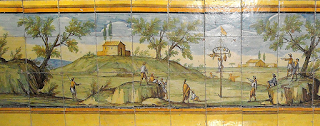Bill
Bryson, writer of many entertaining non-fiction works including Down Under and A Short History of Nearly Everything dedicates several pages in his
2013 book One Summer: America 1927 to
an eventful story of 70 000 smuggled rubber seeds and a young English
adventurer in Brazil.
While
the Herbert River Valley in the late 1870s was on the frontiers of exploration
and settlement, it was just that, the unknown potential, that attracted men and
women from all of the world, both moneyed and those of meagre means. While some
came and persevered, the vast majority, came, ventured and went on to disappear
into the ether or go on to make their mark somewhere else in the world. One such
was a Henry Alexander Wickham, that
very same adventurer who had ventured to Brazil in 1871.
When
he died in 1928 at the fine old age of 82, and by then Sir Henry Wickham, he
was variously described as ‘father of the rubber industry of the British Empire’
or a “living [Sir Walter] Raleigh” or a “smuggler” who was responsible for the
industry that “has changed the habit of civilisation and put 35,000,000
automobiles and 40,000,000 bicycles on the roads of the world.”
So
what was he doing in the Herbert River Valley? Bill Bryson recounts that after
Wickham had sold his 70 000 rubber seeds to the Royal Botanic Gardens at Kew
for a good amount “With the money thus made, Wickham went to Queensland, in
Australia, to start a tobacco plantation.” While he is described in the Herbert River Story as American, American
he was not. He was English, though he spent much of his adult life in the colonies.
A short obituary gives these details: Sir Henry Wickham was born in 1846. He was
explorer and pioneer planter for half a century in the equatorial belt, Central
America, Orinoco, Amazon Valley, Australia, New Zealand and the Pacific
Islands. He was sometime Commissioner for the Introduction of Para Indian
rubber for the Governor of India, and also inspector of Forests and Commissioner
of Crown Lands.”
The
thing about popping up in the colonies is that you can be anything and anybody
you want to be and so Henry Wickham, arriving in the Valley in circa 1877 after
his failed plantation venture in the far north of Brazil (as described by Bill
Bryson) convinces a Mr. J.E. Hammick that he is a tobacco expert from the
Americas and they embark on growing tobacco together at Hammick’s property of
Coolamantong. Meanwhile Henry Wickham
has bought his own property called Maragen.
Douglas R. Barrie in Minding by
Business: The History of Bemerside and the Lower Herbert River District of
Queensland Australia recounts the difficulties Wickham and Hammick faced
growing tobacco in the Valley. As Barrie recounts it wasn’t that they couldn’t
produce a good grade of leaf, it was that they couldn’t cure it quick enough to
meet the large local demand, so the product they had to market was in the end inferior
and did not meet the discerning standard of the local market!!
Wickham
also tries some coffee growing. Coffee, tobacco, sugar, cotton, these were
plantation crops that were looked to as potentially securing the settlement and
economic viability of the north. He seems quick to blow his own trumpet for already in October 1877 the Acclimatisation Society notes
a letter they had received from Henry Wickham detailing that he was having
success with coffee growing. The Society records that “…it appeared that plants
of the Liberian coffee, which that gentleman had himself imported from Kew,
were thriving vigorously on the Lower Herbert, and that there could be no
question of the climate being suited to this very promising addition to the exotic
plants of commercial in the colony. Whether it would become a staple product was
of course quite uncertain; but the fact of the plant being found in dry, hot situations,
near the sea level, afforded great encouragement for believing that it would
freely yield its fruit in Queensland.”
However
it would seem that nothing of his plantation ventures in the Valley inspires Wickham
with optimism to continue here, despite his initial flurry of hopefulness, and so by 1882 he ceases tobacco and coffee growing and
leaves the district soon after. However much of the 569 acres of land he ownes was not disposed of until much later. Some of it became the Mount Maragen Town
Selections. While a town as envisaged never developed, Bemerside eventually
became that township with the Seymour Hotel built on one of the larger of the
town blocks.
 |
| Sir Henry Wickam, drawn by Tom Cottorell for the Advertiser in 1928. |
When
he left the Herbert River Valley after his failed tobacco growing attempt Bill
Bryson writes that “Then he went to
Central America, to British Honduras, to grow bananas. That venture failed,
too. Nothing if not resilient, Wickham recrossed the Pacific to British New
Guinea (now Papua New Guinea), took out a twenty-five-year lease on land in the
Conflict Island, and set about collecting sponges, cultivating oysters and
producing copra from coconuts. At last he achieved modest success, but the
isolation was more that his wife could bear. She decamped to Bermuda and never
saw him again.”
Sources:
“Sir Henry Wickham Dead,” News, September 28, 1928, 15.
Barr-Linney,
J. “Adventurers of the Century: Sir Henry Wickham, A Living Raleigh,” The Advertiser, May 5, 1928, 23.
Illustrator Tom Cottorell
“Smuggler
Founded Great Industry. Sir Henry Wickham and the Rubber Seed,” The Southern Mail, February 4, 1936, 3.
“Death
of Pioneer Planter,” The Telegraph, September
29, 1928, 8.
“Queensland
Acclimatisation Society,” The Queenslander, October 13 1877, 22.
Barrie,
Douglas R. in Minding by Business: The
History of Bemerside and the Lower Herbert River District of Queensland
Australia. Ingham: Douglas R. Barrier, 2003.
Bryson, Bill. One Summer: America 1927. London: Transworld Publishers, 2013.
Vidonja Balanzategui, Bianka. Herbert River Story. Ingham: Hinchinbrook
Shire Council, 2011.



